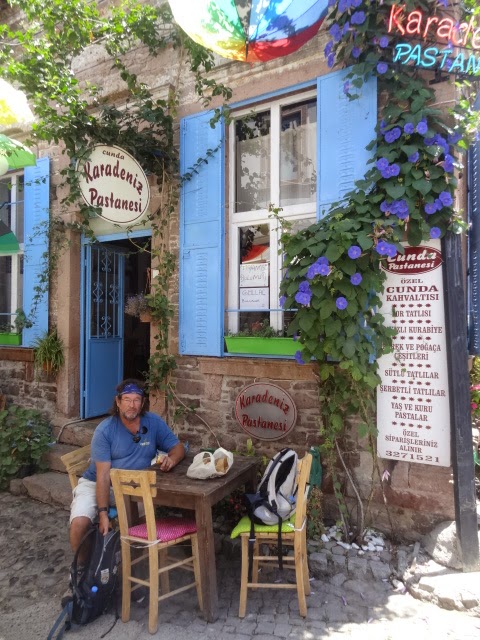I was a committed Pagan as a child. Anglican Sunday School
was all about being nice and giving to the poor, but my religious passion was
reserved for the Greek mythology that I devoured insatiably from about the age
of eight. The myths and legends were like an epic soap opera – gods with
awesome power and human qualities like love, jealousy, arrogance, rage, grief;
gods who interfered in the human world in vengeful or whimsical ways, wrecking
our best-laid plans and mocking human pride. They were great stories. My heroes
were Heracles and Odysseus, my personal deity, the goddess Athena. (I think it
helped that there were plenty of good roles for women in the pantheon!) A
little later I read and reread Homer’s Iliad
and Odyssey, transported to the
‘wine-dark sea” and the “ringing plains of windy Troy”. And now here we are
sailing those same seas, and visiting the ruins of that once-great wealthy
city.
The wooden horse from the film Troy, in Canakkale Harbour
Troy. Established as a real place rather than just a legend
by the German entrepreneur/ archaeologist/ treasure-hunter/ thief Heinrich
Schliemann in the 1870s, the city is at least 9 cities built in layers on top
of each other. The Troy of Homer appears to be about “Troy VII”. The hoard of
treasure that Schliemann smuggled out to Germany, that he called “Priam’s
Treasure” for publicity purposes, actually seems to have come from a much
earlier period. Mustafa Askin, the writer of an excellent guidebook on Troy,
generously describes Schliemann as having “the cunning of Odysseus” in his various
dealings with Turkish authorities. From
another perspective, however, without his dedication and belief in the project,
Troy might still be just an idea hovering in the no-man’s-land between myth and
ancient history.
The site itself is not so remarkable, after the ruins of
Ephesus and Pergamon. It is really not much more than lots of walls at
different levels. What is really impressive is to stand at the highest point
and to look over the coastal plain to the sea, and the Island of Bozcaada
(Tenedos) beyond. This is what Helen would have seen as she surveyed the battle
from her tower – the vast Greek fleet beached, with a gated wall and moat constructed
to protect the ships (Homer tells us that Poseidon destroyed the wall once the
Greeks left), the tide of battle ebbing and flowing as the Greeks pushed the
Trojans back to their city gates, then the Trojans pushed them back to the
ships. At the end of the siege the Greek fleet was hidden behind Tenedos as
they waited for the signal from those who had penetrated the city (by means of
a wooden horse or an earthquake, depending on the story you prefer).
Now you can see several large mounds out towards the water,
and there is some evidence that one of these could be the funeral mound where
the bones of Achilles lie, mingled with those of his beloved friend Patroclus.
It is fertile farmland; that, and the strategic position as a trading point
between east and west had made Troy massively wealthy – probably the real
reason for the siege, rather than the retrieval of Helen, "the face that launched a thousand ships".
The coastal plain, with the funeral mound of Achilles (?)
Rereading The Iliad
is quite a confronting experience. I think the one I read earlier must have
been a children’s translation, as this one is absolutely brutal – definitely in
the genre now known as “battlefield gothic” where the emphasis is on extreme
violence and graphic descriptions of weaponry and wounds. Because we are also
on the site of a twentieth century battlefield, the Gallipoli Peninsula,
drawing comparisons and contrasts is inescapable. To me, the clearest
comparison is that both wars involved the pointless sacrifice of thousands of
young men for a cause that, on the invaders’ side at least, had little to do
with them. Then there is the idiocy of command, from Agamemnon’s imperious offence
to Achilles, to the criminal waste of life at the battle of the Nek. Then the
consequences of both battles: the Trojan War defined “Greece” as an empire and
led to the foundation of Rome (in legend, at least, Priam’s son Aeneas flees
the burning city and founds a new settlement in Italy.) In 1915, the Gallipoli
campaign gave a sense of nationhood to the ANZAC countries and, under the
inspired leadership of Mustapha Kemal Ataturk, saw the birth of modern Turkey.
There are contrasts too, beyond the obvious one that the home side lost the
first war and won the second. Homer lovingly describes the armour, weapons and
physical attributes of each warrior – the golden horsehair plume of Achilles’
helmet, the fearsome stature of Ajax Telemon, Hector’s famous ringing
battle-cry, how their swords and shields were fashioned, the deeds of their
fathers and their sponsoring gods. No such testimonials for what Wilfred Owen
described as “those who die as cattle”. The mass slaughter of WWI is horrifying
and dehumanising.
Lone Pine memorial
Anzac Cove
We toured the Gallipoli Peninsula with Crowded House, who offer a well-organised operation and
knowledgeable guides. No matter how much you’ve read, how many films and
documentaries you’ve seen, it is still an emotional experience to stand on the
beach at Anzac Cove, to step the few short metres between the Allied and
Turkish trenches at The Nek, to imagine the thousands dead in a day in the
small field at Lone Pine, to read the gravestones and feel a world of loss in
the simple inscriptions. There were three young guys from Melbourne with us on
the tour, all in their mid- twenties. It was sobering to think that 100 years
ago, Ryan, David and Jase would have been in uniform, and probably only one of
them would have made it home to Australia.
.JPG)























